You have to hand it to Marker. Ever since they shook our world with their Duke combo tour/alpine binding in 2007, the boys in Penzberg have been tweaking their basic design. Better durability. Better function. Multiple models with the same form factor, such as the F 12 we look at here, as well as the F 10 and Baron. Marker is listening to feedback and leaving no plastic unmolded nor screw unturned. Quite impressive for only four seasons or so of consumer use. We recently received our test pair of production Marker Tour F 12 updated 2011/2012. Take a “first” look.

Marker Tour F 12 and F 10 are constantly improved. This season's version continues the trend. Do they deserve the goblet of roses? Time will tell but the colors match so there.
A few quick points: Toe height adjustment has increased range to fit more AT boots. Rollers in toe wings are now plastic blocks that are said to incur less wear from tech fitting equipped boots. Mode change lever is easier to grab with gloved finger. Numerous changes mitigate icing problems. Evolved more wear resistant touring pivot is stronger. Shape of base plate and binding frame changed so binding sits flatter with less stress, as well as providing improved mating of frame and plate. Heel unit is improved for reliable step-in with various boot heel shapes. At some point over the last 12 months or so, the heel lifter configuration on the Marker Tour series was slightly improved as well (probably what they call an “in-line” change), though we didn’t see any change to the lifter specific to this 2011/12 model. Check it all out in pictures.
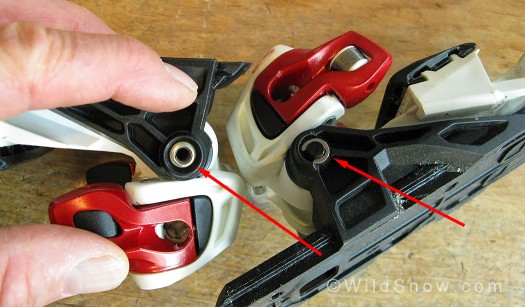
The all important pivot (new version to left), at least for those of us who slog uphill. We were less than pleased with the Marker Tour offerings prior to this year, as the pivot seemed to wear out unacceptably fast if used for more than occasional touring. This year's is improved by not only being larger diameter, but having a Teflon bushing. All AT binding pivots will wear out eventually. Thus, so long as the improvements cause the Marker to last in similar fashion to other bindings then we give it a nod. This winter's testing will tell the tale. Regarding last year's model, for occasional use as a touring binding even the old style pivot has been perfectly adequate. So if you're looking for a bargain slackcountry binding last year's model could still be a good value.
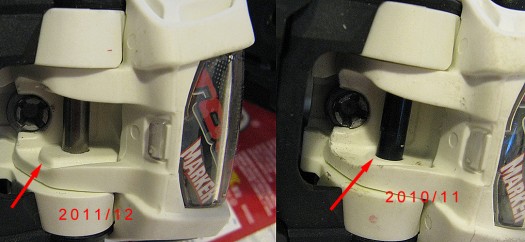
Another view of the pivot and associated plastic. Notice how the new binding (left) has beefed area around pivot axle. The only thing holding the toe unit on the Marker Tour F 12 and F 10 is the pivot axle, so it all needs to be as beefy as possible.
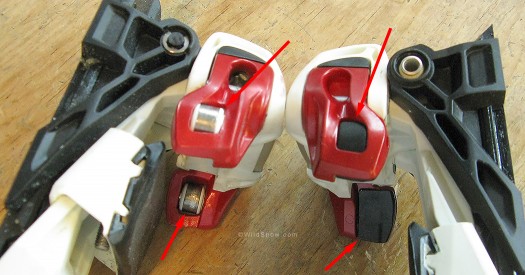
Another big change, along the lines of making this more of a touring binding. Older version (left) had anti-friction rollers in the toe wings that tended to incur damage from AT boots with tech fittings. New version has hard plastic insert in same area that is said to deal better with tech fittings riding against it.
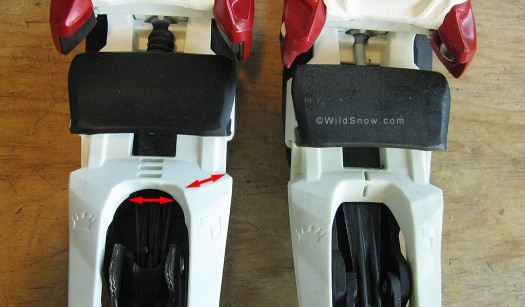
Previous model F Tour might have been a bit weak in the frame at the toe area. At the least, it tends to be fairly twisty in tour mode, especially while sidehilling. New version (to left) has noticeable beef in that area.
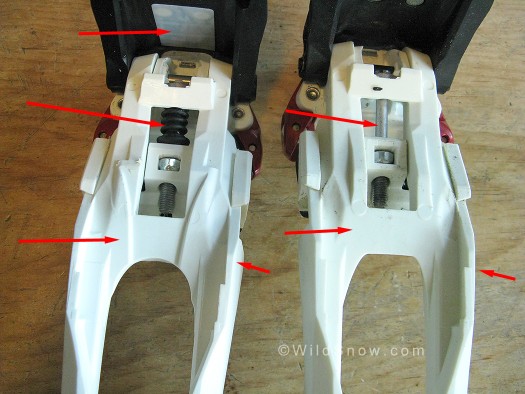
Marker Tour F 12/10 frame underside, 2011/2012 model to left. Upper left arrow points to anti-icing Teflon tape on new model. Left middle arrow points to anti-icing rubber boot on AFD height adjustment screw. One problem with the Marker design is it doesn't clear ice buildup well while being used in tour mode. Small improvements such as these probably make a huge difference. Much of the breakage reported with Marker touring bindings has been due to ice buildup causing extreme leverage on binding parts, so these anti-icing changes should result in better durability. Even so, if you use this type of binding for touring, spray with silicone before each trip, and clear any ice buildup before it causes problems. Lower arrows point to changes in shape of binding frame. The frame shape is stronger, and also sits flat on ski in touring mode without being slightly bent when weighted, as the older model did.
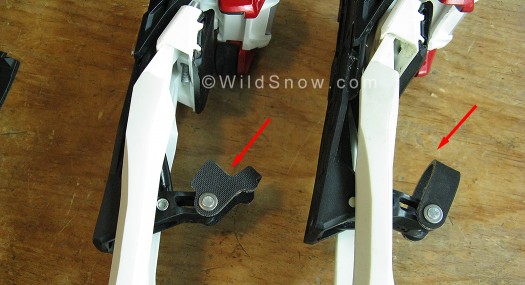
Previous incarnation (right) of mode change finger pull was sometimes hard to snag with a gloved finger. New version to left is shaped differently and said to be easier.
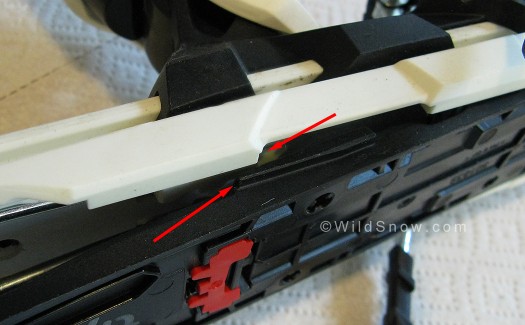
Small but important change, rear baseplate has tapered flanges (lower arrow) so the frame (upper arrow) slides easier into alpine mode. This alone makes the new version a much better buy than the old.
A word of advice about using any Marker touring type binding (Duke, Tour F, etc.): Due to the nature of any frame binding, while sidehilling in tour mode you’ll experience quite a bit more flex and deflection of your boot heel and climbing lift than you do with a tech binding. Previous incarnations of the Markers have quite a bit of this type of flex, and some ski alpinists have found it to be too much. This new version appears to be stiffer, but my bench testing shows it’ll still flex quite a bit. Key with this is getting accustomed to this type of flex, as well as accepting it as a tradeoff for having the solid alpine-binding performance these grabbers give you when you lock your heel down — especially in terms of vertical elasticity in the heel as compared to a tech binding.
Weights: Previous version F 12 for 2010/11 weighs 1040 grams, 36.7 ounces (with brakes and screws), new version is 4/10 of an ounce (11.3 grams) heavier. In other words, 2011/2012 Marker F 12 weighs 37.1 ounces, 1051 grams (the F 10 version of this binding may be slightly lighter, but not impressively so from what we saw last season. We’ll be checking.)
Shop for ’em. Note: Tough to know which version of these an online store is selling. The link I give here is for the 2010/2011 version (I asked), official word is that new version will start shipping mid October. ID new version by the dark plastic inserts in the toe wings where the shiny rollers used to be, otherwise the two versions of the binding are hard to tell apart. Original version works fine if you’re mostly keeping your heels locked down. If you plan on much touring, we only (tentatively) recommend the new version and hope it tests out well enough for a full review just as soon as we get it on snow.
WildSnow.com publisher emeritus and founder Lou (Louis Dawson) has a 50+ years career in climbing, backcountry skiing and ski mountaineering. He was the first person in history to ski down all 54 Colorado 14,000-foot peaks, has authored numerous books about about backcountry skiing, and has skied from the summit of Denali in Alaska, North America’s highest mountain.
